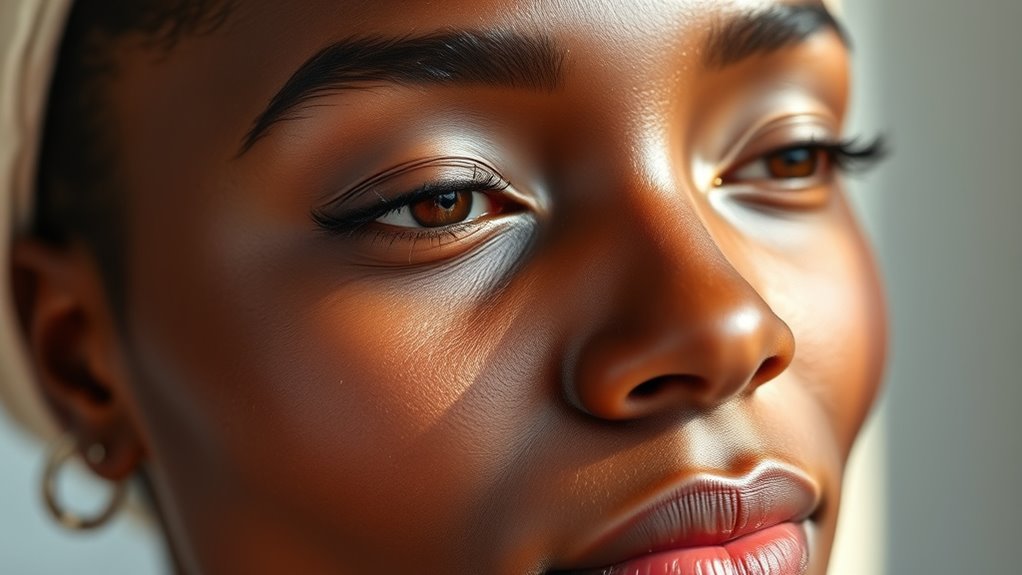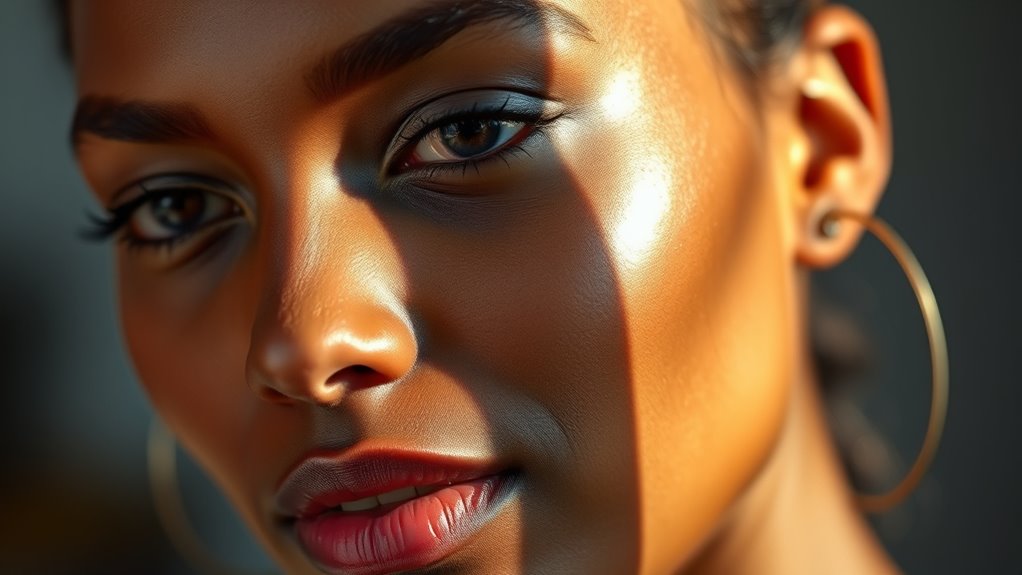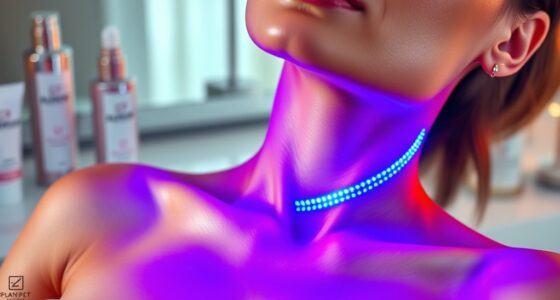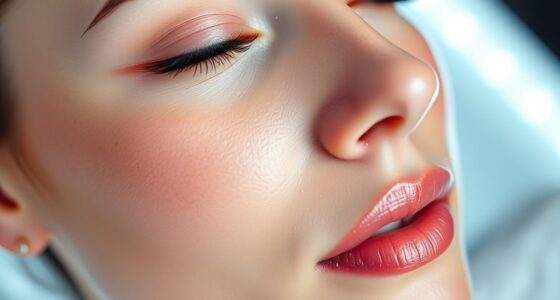For gentle brightening on darker skin tones, choose LED devices that emit red and near-infrared light, as these penetrate deep and promote overall skin radiance safely. Start slow with shorter sessions and lower intensities, gradually increasing as your skin adapts. Always follow manufacturer instructions and protect your skin with sunscreen afterward. Being patient and consistent helps enhance your glow without irritation. Keep this tips in mind, and you’ll discover more ways to achieve a luminous complexion.
Key Takeaways
- Use LED devices with red and near-infrared wavelengths for safe, deep skin penetration and effective brightening on darker skin tones.
- Start with shorter sessions and lower intensities, gradually increasing to prevent irritation and hyperpigmentation.
- Follow manufacturer instructions and consult a dermatologist for personalized, safe treatment plans.
- Incorporate supportive skincare like gentle, hydrating products and daily sunscreen to enhance LED results.
- Be patient; consistent use over several weeks yields brighter, more even skin while minimizing risks.

If you have darker skin tones, choosing the right LED treatments can make a significant difference in their effectiveness and safety. Unlike lighter skin, where certain wavelengths can produce dramatic results quickly, darker skin requires a more cautious approach to avoid potential side effects like hyperpigmentation or irritation. LED treatments work by stimulating cellular activity, promoting collagen production, and improving skin tone, but not all wavelengths are suitable for everyone. For darker skin tones, red and near-infrared lights are generally considered the safest and most effective options. These wavelengths penetrate deeper into the skin, encouraging healing and brightening without risking pigment changes. Blue light, often used for acne treatment, can be safe if used properly, but it’s less effective for overall brightening in darker skin.
Darker skin tones benefit from red and near-infrared LED lights for safe, effective brightening and healing.
When you’re selecting LED devices or treatments, prioritize those designed specifically for darker skin tones. Devices with adjustable settings give you more control, allowing you to tailor sessions to your skin’s response. It’s essential to start with shorter sessions and lower intensities, gradually increasing as your skin becomes accustomed to the treatment. Overdoing it can lead to irritation or uneven pigmentation, which is especially risky if your skin is prone to hyperpigmentation. Always follow the manufacturer’s instructions and consult with a dermatologist to determine the best treatment plan for your skin type. They can recommend appropriate wavelengths and session durations, helping you avoid common pitfalls like overexposure.
Another key tip is to incorporate a good skincare routine alongside LED therapy. Use gentle, hydrating products that support your skin’s barrier, and always apply broad-spectrum sunscreen during the day. Sun exposure can exacerbate hyperpigmentation, particularly after LED treatments, so protecting your skin is essential. You should also be consistent with your treatments but give your skin enough time to recover between sessions. Typically, once or twice a week is sufficient, but this can vary depending on your skin’s response and the device used. Patience is key; visible brightening may take several weeks of regular treatments.
Lastly, remember that darker skin tones are resilient and capable of radiance with proper care. LED therapy can boost your skin’s health and brightness without aggressive procedures, but it must be approached thoughtfully. With the right wavelength, proper precautions, and consistent skincare, you can safely enhance your skin’s natural tone, achieving a more even, luminous complexion over time.
Frequently Asked Questions
Can LED Treatments Cause Hyperpigmentation on Darker Skin?
Yes, LED treatments can cause hyperpigmentation on darker skin if not used properly. You might be at higher risk if the treatment is too intense or if the wavelength isn’t suitable for your skin tone. To avoid this, always consult a trained professional who understands your skin type. They’ll adjust the settings and monitor your progress, ensuring you get safe, effective results without unwanted pigmentation changes.
How Often Should Darker Skin Tones Undergo LED Therapy?
You should have LED therapy on darker skin tones no more than once every two weeks. This frequency allows your skin to recover and reduces the risk of hyperpigmentation. Always follow your dermatologist’s advice and monitor your skin’s reaction after each session. If you notice any irritation or darkening, adjust the interval accordingly. Consistent, gentle treatments help brighten your skin without causing damage.
Are There Specific LED Wavelengths Best for Darker Skin?
Did you know that specific LED wavelengths can target skin concerns effectively? For darker skin, you should focus on wavelengths around 630-660 nm (red light) and 830 nm (near-infrared), as they promote collagen production and healing without causing hyperpigmentation. These wavelengths penetrate deeply, making them ideal for brightening and rejuvenating darker skin tones. Using the right light guarantees safe, noticeable results while minimizing risks of pigmentation issues.
What Are the Potential Side Effects of LED for Dark Skin?
You might experience mild side effects like redness, swelling, or irritation after LED treatments, especially if your skin is sensitive. In rare cases, overuse can cause dryness or hyperpigmentation. Always follow the recommended treatment schedule and use gentle products afterward. If you notice persistent discomfort, stop using the device and consult a dermatologist. Proper use mitigates risks and ensures you get the benefits safely.
Can LED Treatments Replace Traditional Skin Brightening Methods?
LED treatments can complement traditional skin brightening methods but shouldn’t fully replace them. They offer non-invasive, gentle options that target specific skin concerns, making them suitable for darker skin tones. However, for ideal results, you may need to combine LED therapy with skincare routines like exfoliation, moisturizing, and sun protection. Always consult a dermatologist to develop a personalized plan that best suits your skin type and goals.
Conclusion
Now that you know how gentle LED treatments can brighten your darker skin tones, you’re all set to glow like a modern-day Cleopatra. Remember, consistency is key—think of it as your secret weapon, much like a knight’s trusty sword. Embrace these tips, stay patient, and trust the process. Before you know it, you’ll be shining brighter than a 1920s flapper’s diamond, confident in your radiant, even complexion.









